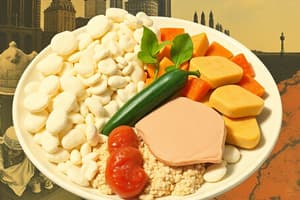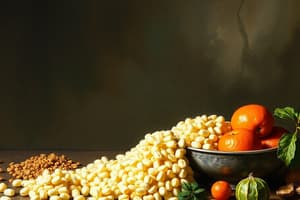Podcast
Questions and Answers
Which condition is associated with vitamin C deficiency?
Which condition is associated with vitamin C deficiency?
- Vision impairment
- Scurvy (correct)
- Rickets
- Poor teeth
Which factor does not increase energy requirements?
Which factor does not increase energy requirements?
- Inactivity (correct)
- Activity level
- Age
- Pregnancy
What is the energy needed to raise the temperature of one gram of water by 1°C?
What is the energy needed to raise the temperature of one gram of water by 1°C?
- 2.1 joules
- 10 joules
- 1 joule
- 4.2 joules (correct)
Which of the following steps is not part of the procedure to investigate the energy content of a food sample?
Which of the following steps is not part of the procedure to investigate the energy content of a food sample?
How does pregnancy affect energy requirements?
How does pregnancy affect energy requirements?
What is one primary function of carbohydrates in the human body?
What is one primary function of carbohydrates in the human body?
Which of the following is a source of glucose?
Which of the following is a source of glucose?
Why is starch significant in human diets?
Why is starch significant in human diets?
Why can humans not use cellulose as an energy source?
Why can humans not use cellulose as an energy source?
Which statement about lipids is true?
Which statement about lipids is true?
Which of these foods is most likely to be a source of dietary fiber?
Which of these foods is most likely to be a source of dietary fiber?
How is glycogen similar to starch?
How is glycogen similar to starch?
Which of the following contributes to preventing diseases of the intestine?
Which of the following contributes to preventing diseases of the intestine?
Which of the following is a source of lipids?
Which of the following is a source of lipids?
What is the primary function of proteins in the body?
What is the primary function of proteins in the body?
Which vitamin is crucial for vision, especially in the dark?
Which vitamin is crucial for vision, especially in the dark?
Which mineral deficiency is associated with poor bone development?
Which mineral deficiency is associated with poor bone development?
What is a significant consequence of protein deficiency?
What is a significant consequence of protein deficiency?
Which food sources are rich in iron?
Which food sources are rich in iron?
What role does sodium play in the body?
What role does sodium play in the body?
Which vitamin is synthesized in the skin when exposed to sunlight?
Which vitamin is synthesized in the skin when exposed to sunlight?
Flashcards
Carbohydrates: What is their function?
Carbohydrates: What is their function?
A food substance that provides energy for cells. Cells break down glucose through a process called cell respiration to release energy.
What is starch?
What is starch?
A large carbohydrate molecule made up of many glucose molecules linked together. Found as a storage carbohydrate in plants like potatoes, rice, and wheat.
What is cellulose?
What is cellulose?
A complex carbohydrate that is found in plant cell walls. Humans cannot digest it, but it is important for digestion.
What's the difference between fats and oils?
What's the difference between fats and oils?
Signup and view all the flashcards
What is a balanced diet?
What is a balanced diet?
Signup and view all the flashcards
What is digestion?
What is digestion?
Signup and view all the flashcards
What is glucose?
What is glucose?
Signup and view all the flashcards
What is glycogen?
What is glycogen?
Signup and view all the flashcards
Scurvy
Scurvy
Signup and view all the flashcards
Rickets
Rickets
Signup and view all the flashcards
Digestion
Digestion
Signup and view all the flashcards
Energy Requirements
Energy Requirements
Signup and view all the flashcards
Investigating the energy content of a food sample
Investigating the energy content of a food sample
Signup and view all the flashcards
What are the functions of lipids?
What are the functions of lipids?
Signup and view all the flashcards
What lipid types can harm your health?
What lipid types can harm your health?
Signup and view all the flashcards
What are the functions of proteins?
What are the functions of proteins?
Signup and view all the flashcards
Why are proteins vital for our bodies?
Why are proteins vital for our bodies?
Signup and view all the flashcards
What is the function of calcium in the body?
What is the function of calcium in the body?
Signup and view all the flashcards
What does iron help with in the body?
What does iron help with in the body?
Signup and view all the flashcards
What is Rickets?
What is Rickets?
Signup and view all the flashcards
What is Anaemia?
What is Anaemia?
Signup and view all the flashcards
Study Notes
Nutrition in Humans
- Food is needed to provide energy, repair tissues, and fight disease.
- A balanced diet includes carbohydrates, lipids, proteins, minerals, vitamins, dietary fiber, and water in appropriate amounts.
Carbohydrates
- Sugars:
- Glucose is found naturally in fruits and vegetables.
- Fructose is found in fruits.
- Lactose is found in milk.
- Sucrose is transported through plant stems (e.g., sugar cane).
- Digestion of starch produces sugar.
- Physical Properties of Sugars:
- Sugars are soluble in water.
- Sugars are sweet in taste.
- Functions of Sugars:
- Sugars provide energy for cells by oxidation in cellular respiration.
Starch
- Starch is a large, insoluble carbohydrate found in plants (e.g., potatoes, rice, wheat).
- Starch is a polymer of glucose molecules.
- Starch is a storage form of glucose in plants.
Glycogen
- Glycogen is a carbohydrate similar to starch, found in animal tissues (e.g., liver, muscle).
- Glycogen is a storage form of glucose in animals.
- Large carbohydrates like starch and glycogen must be broken down into simple sugars for absorption into the bloodstream following digestion.
Cellulose
- Cellulose is the material that makes up plant cell walls.
- Humans cannot digest cellulose because they lack the necessary enzymes.
- Cellulose acts as dietary fiber, promoting gut health and preventing constipation.
Lipids
- Sources and Properties:
- Fats are derived from animals (solid at room temperature) and have high melting points.
- Oils are derived from plants (liquid at room temperature) and have low melting points.
- Sources of fats: animal products, milk, butter, ghee, eggs, fish.
- Sources of oils: vegetable oils, corn oil, olive oil, etc.
- Functions of Lipids:
- Lipids contribute to body mass.
- Lipids are crucial components of cell membranes.
- Lipids are stored as energy reserves.
- Lipids insulate the body.
- Lipids protect organs from damage.
Proteins
- Sources:
- Animal sources: meat, fish, cheese, eggs.
- Plant sources: beans, peas, nuts.
- Functions:
- Proteins promote growth.
- Proteins repair damaged tissues.
- Proteins are components of many enzymes in the body.
- Recommended Amount: Approximately 70 grams per day.
- Deficiency: Kwashiorkor is a protein deficiency disease.
Minerals
- Minerals:
- Calcium is important for bone and tooth formation.
- Phosphorus is important for making bones and teeth.
- Sodium is a component of body fluids (e.g., blood).
- Chlorine is a component of body fluids (e.g., blood).
- Magnesium is found inside cells.
- Iron is a component of haemoglobin (red blood cells).
- Deficiency:
- Rickets is a calcium deficiency disease causing poor bone development.
- Anemia is an iron deficiency disease causing tiredness.
Vitamins
- Vitamin A:
- Source: carrots, liver, fish liver oil.
- Role: Crucial for vision and maintaining the health of the eyes.
- Vitamin C:
- Source: fresh fruits, vegetables.
- Role: wound healing and maintaining the health of the cells lining body surfaces.
- Vitamin D:
- Source: fish liver oil, sunlight.
- Role: helps bones absorb calcium and phosphate.
- Deficiency:
- Vitamin A deficiency: night blindness, damaged cornea.
- Vitamin C deficiency: scurvy.
- Vitamin D deficiency: rickets, poor teeth.
Water
- Water is essential for all chemical reactions in the body.
- Water is found in juices and liquids.
Energy Requirements
- Factors affecting energy requirements include age, activity level, and pregnancy.
- Energy and activity levels increase as we age and increase with increases in activity.
- Energy needed during pregnancy is higher due to the additional mass.
- Investigation of food energy content is done by measuring the mass of food, placing it in water, and recording the temperature change in the water.
Studying That Suits You
Use AI to generate personalized quizzes and flashcards to suit your learning preferences.
Related Documents
Description
This quiz explores the crucial role of food in human nutrition, emphasizing the importance of a balanced diet and the functions of carbohydrates like sugars, starch, and glycogen. Test your knowledge of dietary components and their physiological roles.




